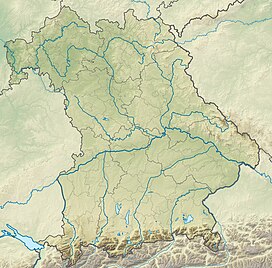Großer Waldstein
| Großer Waldstein | |
|---|---|

The Schüssel observation pavilion
|
|
| Highest point | |
| Elevation | 877 m above sea level (NN) (2,877 ft) |
| Coordinates | 50°07′44″N 11°51′18″E / 50.12889°N 11.855°ECoordinates: 50°07′44″N 11°51′18″E / 50.12889°N 11.855°E |
| Geography | |
| Parent range | Fichtel Mountains |
The Großer Waldstein is part of the Waldstein range in the Fichtel Mountains of Germany. It is known primarily for its rock formations caused by spheroidal weathering, its ruined castles and the only remaining bear trap (Bärenfang) in the region.
The Großer Waldstein (877 m above sea level (NN)) is a mountain in the northern part of the Fichtel Mountain Horseshoe. Its summit area is covered by mixed forest with old stands of beech and huge rock piles, and the whole area is a designated nature reserve (20.2 hectares (50 acres)). Marked hiking trails lead from all points of the compass to the mountain, and public roads run from Weißenstadt or Sparneck to the area of the summit. At the top is a lodging house owned by the Fichtelgebirge Club, the Waldsteinhaus, from which there is an interesting walk around the summit area.
The Jean Paul Way also crosses the Großer Waldstein. The Kleiner Waldstein and Hoher Stein are other rock formations on the Bergkopf. At the Großer Waldstein the Zellerfels are a rock formation. The source of the River Saale rises at the foot of the Großer Waldstein near Zell im Fichtelgebirge.
To the east, opposite the Waldsteinhaus, rises a massive rock face, on which the remains of the once mighty fortress of Waldstein is perched. The castle is now often referred to as the Red Castle (Rotes Schloss) and for a long time it was assumed that this was because the palace had been covered with red tiles when it was built in the 14th century. This assumption is wrong, however. The name 'Red Castle' came from the fact that parts of the castle ruins were re-roofed during the Spanish War of Succession (1701–1714) in order to build a camp there. It was this new roof that was covered with red tiles, which can still be found around the castle. The term 'Red Castle' was coined by the headmaster of Hof Grammar School (Hofer Gymnasium), Helfrecht, who referred to it as such in his first work published in 1795, because he believed that the castle had always been covered with red tiles. Since almost all later researchers followed suit, the idea became accepted. Only Karl Dietel refuted this incorrect assumption in his work Der Große Waldstein im Fichtelgebirge.
...
Wikipedia

